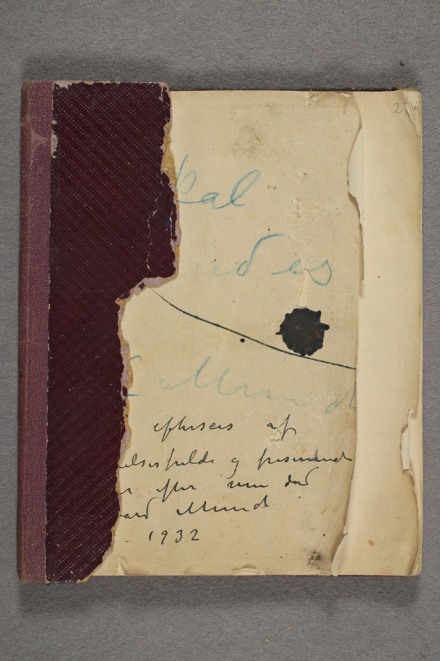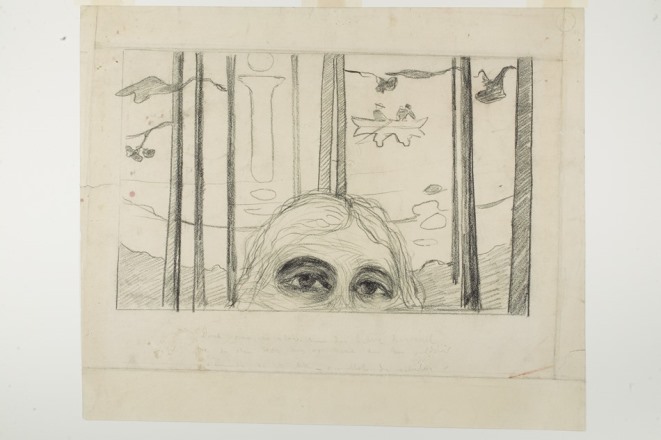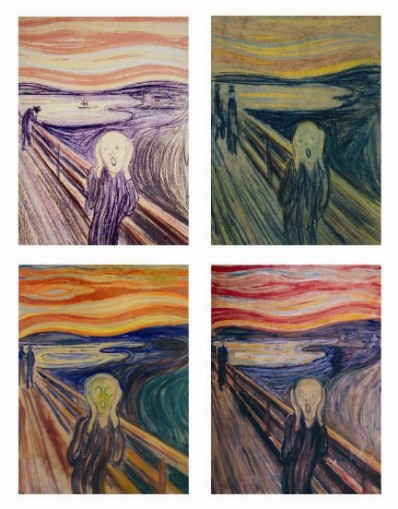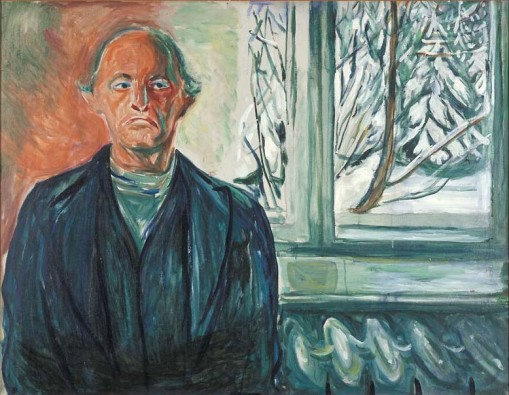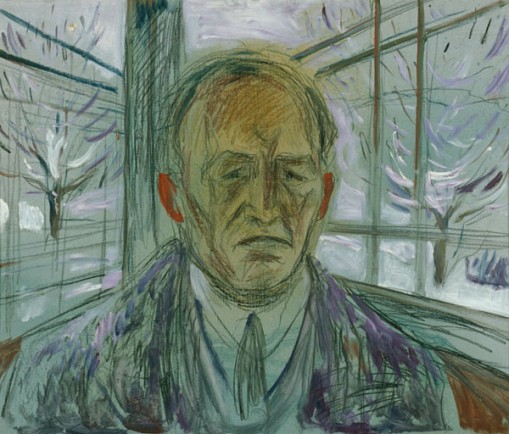Ashes
MM N 505, p. 1
Listen to a reading of the text
Ashes
During all that time he had
in fact forgotten that she was
married – Any thought of the Captain had
only fleetingly passed him by.
– It had in fact never
occurred to him either that
things should end this way – not until this moment
sitting in this large dark
cold room with the fluttering
candle flames did he see everything clearly –
He had committed fornication – he had
deceived the tall Captain – he
had thrown himself into something that
caused him remorse – his Father – and the others at home
And the time he felt love
and the time they had been together
until now – lay like a heap of ashes – And she with all
the other lovers
© English translation by Francesca M. Nichols
http://www.emunch.no/TRANS_HYBRIDMM_N0505.xhtml
Notes related to art and The Frieze of Life
MM N 46, fol. 1r
In order to understand my remarks
about how I believed it would be a crime
for me to marry I will elucidate the following:
my maternal grandmother died of tuberculosis
My mother died of tuberculosis
as did her sister Hansine
My aunt who came to [live with] us has apparently
been tubercular. Throughout her entire life she has
suffered from colds accompanied by blood-tinged sputum as well as
bronchitis. My sister Sofie died of tuberculosis
We other children suffered from severe colds
while growing up – I came to this world in poor health
was baptised at home and my father did not believe
that I would survive – I was forced to neglect school
almost entirely – Had continuous attacks
of violent colds illness
and rheumatic fever – Had profuse haemorrhaging and
blood-tinged sputum. My brother had weak
lungs and died of pneumonia as a young man
MM N 46, fol. 2r
My paternal grandfather the archdeacon died
of tuberculosis of the spine – Which … I
believe was the cause of my father’s morbid anxiety
and disposition – The likes of which
developed more and more in
us children
I consequently do not believe that my
art is morbid – as Scharfenberg and
many others believe. These are people who do not
understand the essence of art nor are they
familiar with art history
When I paint illness and misfortune
it is on the contrary a healthy release
It is a healthy reaction that
one can learn from and live by
MM N 46, fol. 3r
How I hit upon the idea to paint
friezes and murals
In my art I have sought
to explain to myself life
and its meaning – I have also intended to help others
to understand their own lives
I have always worked best with
my paintings around me –
I arranged them together and felt
that some of the pictures were connected to
each other in content –
When they were positioned together there immediately
arose a resonance between them and
they became totally different than when [displayed] individually
It became a symphony
That is when I decided to paint friezes
“English edition of Munch’s texts” by Hilde Bøe
Members of the staff at the Munch museum have – since January 2012 – worked closely with translator Francesca M. Nichols to translate a selection of Edvard Munch’s texts to English. The result – the English edition – is now launched on emunch.no, the digital archive on Edvard Munch’s writings. The selection of texts is comprised of 68 separate archive objects from the museum’s collection. Together they contain approximately 1100 manuscript pages. The selection is concentrated on Munch’s literary sketches and his texts related to art.
The work has been demanding. Munch’s texts are for the most part handwritten and were never published by Munch himself. Munch’s peculiar style of writing is often fleeting, repetitive and sketch-like. It is often characterised by a lack of attention to grammar, spelling, and sentence structure, and a habitual lack of punctuation – aside from the dash, which is used instead of a period, or to indicate a pause, yet never consistently. Due to the character of his handwriting his texts are often hard to read. It is the museum’s intention that the translations of the texts are as true to Munch’s own style of writing as possible, and for that reason the work involved in this project has been more demanding than is ordinarily the case with translations, where the meaning and content are of primary importance. The primary presentation is a facsimile of the original archival object side by side with the English translation. By presenting this parallel display we wish to remind the readers what type of objects and texts are at hand. Munch wrote throughout his whole life. He wrote on whatever piece of paper he had in front of him. His texts are found in small notebooks and large sketchbooks, on the back of letters from friends and business partners, on the back of drawings, on small torn off pieces of paper. There often exists several versions, written years apart.
Delving into Munch’s written universe as we have done has been a tremendous experience says translator Francesca M. Nichols, and continues, Munch’s ability to convey extreme psychological states, erotic scenes, or descriptive passages that range from morbid obsessiveness to gripping pathos and lyrical heights of passion – not to mention his sense of humour – make for unforgettable reading, which I would recommend to anyone interested in the world of human emotions. – Here’s a taste of what Munch’s texts can offer.
MM N 505, p. 1
Ashes
During all that time he had
in fact forgotten that she was
married – Any thought of the Captain had
only fleetingly passed him by.
– It had in fact never
occurred to him either that
things should end this way – not until this moment
sitting in this large dark
cold room with the fluttering
candle flames did he see everything clearly –
He had committed fornication – he had
deceived the tall Captain – he
had thrown himself into something that
caused him remorse – his Father – and the others at homeAnd the time he felt love
and the time they had been together
until now – lay like a heap of ashes – And she with all
the other lovers
Your eyes are as large as half the sky
when you stand near me and your hair with gold dust
your mouth I do not see – see only that you are smiling
Read more here and please let us know what you think!
Google Art Project
The Munch Museum cooperates with Google in the digital art presentation called the Google Art Project. Now you can watch several of Edvard Munch’s works from  The Munch Museum collection online. Here the public is invited to visit an enourmous selection of art works from all over the world, and have unique opportunities to learn more about single artists and art collections.
The Munch Museum collection online. Here the public is invited to visit an enourmous selection of art works from all over the world, and have unique opportunities to learn more about single artists and art collections.
Google Art Project is like a gigantic digital exhibition. At Google Art Project/The Munch Museum people worldwide now have access to 53 of Edvard Munch’s main works of art, including The Scream. Read more about our cooperation here. The Munch Museum wanted to offer Munch enthusiasts who are not able to visit our museum in Oslo, an interactive Gallery. Now you can create your own “exhibitions” of Edvard Munch’s art, and as a bonus put them together with works by other artists.
 Edvard Munch, “Kiss IV”, 1902 is one of the art works currently exhibited in “Puberty. Summer Exhibition 2012″ at the Munch Museum.
Edvard Munch, “Kiss IV”, 1902 is one of the art works currently exhibited in “Puberty. Summer Exhibition 2012″ at the Munch Museum.
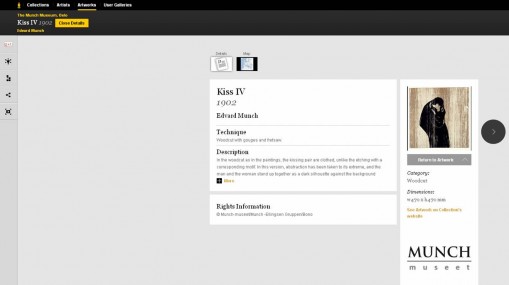 Click for details to find more information.
Click for details to find more information.
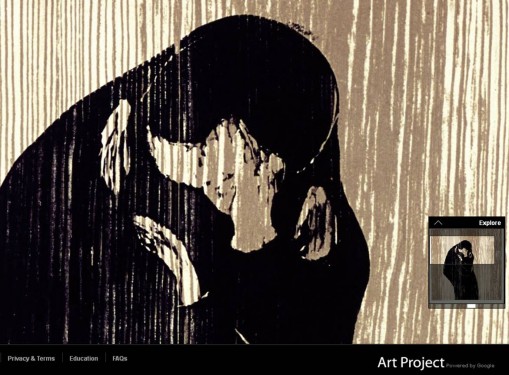 Explore the woodcut and see the lines of the material at close range – even closer than in real life.
Explore the woodcut and see the lines of the material at close range – even closer than in real life.
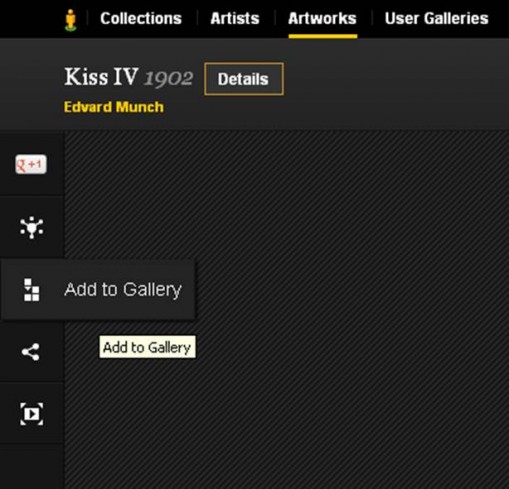 Add to Gallery to create your own exhibition.
Add to Gallery to create your own exhibition.
 Of course you can share your favorites with friends.
Of course you can share your favorites with friends.
Test it out yourself and enjoy! We are very pleased if you like to share your experience with us on Facebook, Twitter/@themunchmuseum or here.
Edvard Munch’s “Puberty” 1894. Study of Technique and Conservation. By Biljana Topalova-Casadiego
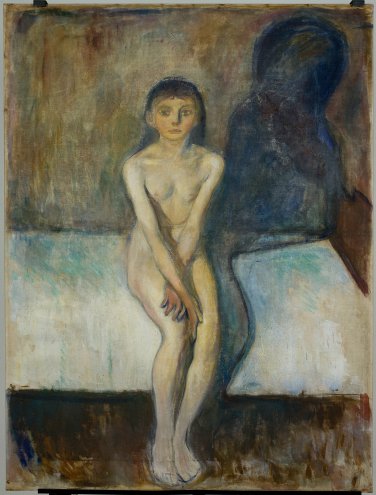 The Munch Museum in Oslo recently opened the Exhibition “Puberty. Summer Exhibition 2012″. As main focal point of this exhibition is Edvard Munch’s Puberty, 1894, a painting that has not been shown to the public for more than ten years. Munch painted several versions of Puberty, though, and the National Museum in Oslo also holds a painted version from the same year which has been available to the public the past years. In addition to this, the Munch Museum holds a Puberty painting from 1914-1916.
The Munch Museum in Oslo recently opened the Exhibition “Puberty. Summer Exhibition 2012″. As main focal point of this exhibition is Edvard Munch’s Puberty, 1894, a painting that has not been shown to the public for more than ten years. Munch painted several versions of Puberty, though, and the National Museum in Oslo also holds a painted version from the same year which has been available to the public the past years. In addition to this, the Munch Museum holds a Puberty painting from 1914-1916.
Edvard Munch’s painting Puberty belongs among the world treasures of modern art. Nevertheless, little investigation into its materials, current condition and treatment history has been made. This actualized the requirement for down-to-earth information about the work as a physical object before carefully considered plans for future treatment and for the prevention of further damage could be drawn up. An extensive investigative and conservation process was therefore initiated. Read more about the conservation of the painting The project was an attempt at a thorough examination and systematic survey of Munch’s main paintings’ “biography”, and particularly its present condition. The work stretched out over a year, and included an analysis of the materials, a study of the problems associated with the painting, as well as finding a responsible method for treating and conserving it for posterity. The examination of Puberty was carried out with support from EU-financed research . A number of specialists both from Norway and abroad have further contributed to this process.
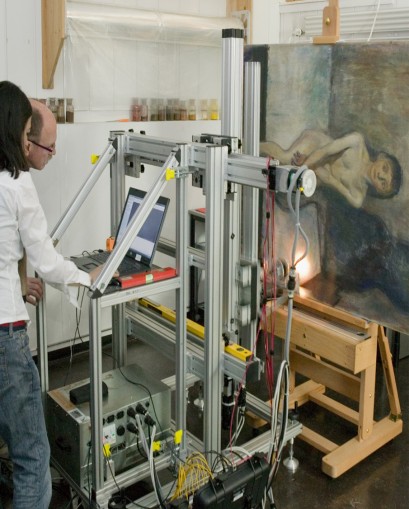
Characteristic of Munch’s work of the period is the varied use of techniques, working processes and treatments of the pictorial surface. Many variations may appear in one and the same work. The use of different technical methods in one painting may be noted particularly in Puberty. The painting is marked by experimentation in the use and handling of the materials – the canvas and paints. Here Munch emphasised the material character of the work by creative juxtaposition and effects, such as the treated painted surface and the exposed canvas. The working method enhances the textural quality of Puberty, which is emphasised by locally applied varnish – this makes any type of treatment, such as successful cleaning or consolidation, very challenging.
The competent preservation of Puberty was a major aim of the project, and involved study of the original materials and of the treatment history as well as how the latter influenced the current condition of the artwork. The work done on Puberty is relevant for the conservation of the remainder of the paintings in the Munch Museum as well. New information derived from this study benefits the entire collection.
A new catalogue has been published with articles written by Jay A. Clarke, Finn Skårderud, Biljana Topalova-Casadiego and Ingebjørg Ydstie.
Paintings on Rolls – by Eva Storevik Tveit
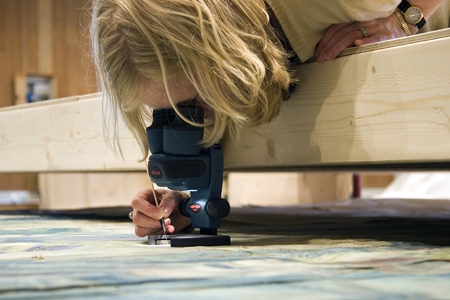 The Conservation Project “Paintings on Rolls” started in March 2006 at the Munch Museum. The project encompassed 31 sketches that Munch painted in connection with the decorations for the University Aula in Oslo, during the period 1909–1916. In addition, the project included 15 other drafts from the period 1909-1930 stored on rolls – including eight of which were painted for the first submitted proposal for the Aula decorations in 1910, The Human Mountain. However, this work was rejected by the jury (Pettersen 2008: 846). Among the other seven sketches, there were three that Munch worked on as a proposal for the decoration of the Town Hall in Oslo, which he never completed, while the last four drafts have other motifs. The drafts measure from 142 cm X 130 cm to 450 cm X 1140 cm.
The Conservation Project “Paintings on Rolls” started in March 2006 at the Munch Museum. The project encompassed 31 sketches that Munch painted in connection with the decorations for the University Aula in Oslo, during the period 1909–1916. In addition, the project included 15 other drafts from the period 1909-1930 stored on rolls – including eight of which were painted for the first submitted proposal for the Aula decorations in 1910, The Human Mountain. However, this work was rejected by the jury (Pettersen 2008: 846). Among the other seven sketches, there were three that Munch worked on as a proposal for the decoration of the Town Hall in Oslo, which he never completed, while the last four drafts have other motifs. The drafts measure from 142 cm X 130 cm to 450 cm X 1140 cm.
The sketches are working drafts and were probably never intended to be mounted on stretchers. Many of the them were stored on rolls during Munch’s own lifetime, and were kept like this after his death as well. As many as six canvases were stacked on the same roll with the paint layers facing inward. The diameters of the rolls measured from 6 cm to 30 cm. With a few exceptions the rolls were placed directly on shelves in the Munch Museum’s storage rooms. The aim of the present conservation project has first and foremost been to improve the storage conditions.
Unlike the smaller sketches that could be stored flat in boxes, the largest canvases still had to be stored on rolls. However, the new rolls have larger diameters. In addition, we have used proper packing material, and the rolling method has been improved: the sketches have been rolled with the paint layers facing outward, we have used one roll for each single draft, and a hanging system has been constructed which allows the rolls to be suspended on poles.
With the exception of five sketches, the works had not previously been examined. The existing information proved to be very limited, so documentation regarding the materials and the condition of the sketches was therefore an important aspect. During the course of the project we have discovered new phenomena of Munch’s art and gained new knowledge about his painting technique, materials and methods.
The Munch Museum has now completed the documentation and treatment of 46 drafts, approximately 400 m2 of painted surfaces. More than 18 conservators have been involved in the project which has been an extraordinary one and has offered several unusual challenges that have required a major collaboration between technicians and conservators. The enormous unstretched formats, for instance, had to be treated while lying horizontally. For this, various bridging systems were constructed in order for the conservators to treat the mid sections of the sketches. Owing to Munch’s choice of materials and to the fact that he both painted and kept many of this drafts out of doors, their condition is extremely frail. Given these special circumstances, it was not practical to employ traditional methods of conservation treatment. In addition, the aim to use a minimum of invasive methods was a challenging and instructive one.
Munch’s “Scream” – the four versions
Edvard Munch’s “Scream” is one of the world’s most famous images – a socalled “iconic image”. It has appeared all over the world in all kinds of contexts and all kinds of editions from street-art and caricatures to The Simpsons and Andy Warhol.
How could it be that there are several paintings by Edvard Munch called “Scream”? The original “Scream” exists in several versions: two painted versions, two pastels, a number of graphic works as well as drawings and sketches. The work now for sale, the pastel from 1895, is now to be sold at Sothebys in New York.
“I was walking along the road with two friends
The Sun was setting – the Sky turned blood-red.
And I felt a wave of Sadness – I paused
tired to Death – Above the blue-black
Fjord and City Blood and Flaming tongues hovered
My friends walked on – I stayed
behind – quaking with Angst – I
felt the great Scream in Nature
E M”
Note PN 12 70
At eMunch.no you find this translated and shortened text which was written down by Munch himself and adapted to the frame of the 1895 pastel. The first time Munch wrote a poetic text that related directly to sketches leading to the “Scream”, was in Nice in 1891/1892 – see some of his first sketches here.
The Munch Museum in Oslo owns the largest collection of Scream versions worldwide, including one oil-painting, one pastel/crayon, 5 graphic prints additional to drawings, sketches and prosa texts related to the development of the motif.
Self-Portrait on the Glass Veranda
Through his life, Edvard Munch painted several self portraits. Currently, Schirn Kunsthalle in Frankfurt is exhibiting Edvard Munch’s “Self-Portrait on the Glass Veranda”, 1930-33 (MM M 446). At the same time, the Munch Museum in Oslo shows two similar paintings made during the same period of Munch’s life at Ekely, nearby Oslo, MM M 242 and MM M 245. The latter is concieved in a combination of oil and crayon on wooden panel. If we compare the versions shown here, the differences are visually obvious.
In the catalogue to the winter exhibition “Sense of snow”, Curator Petra Pettersen describes the works (MM M 242 and MM M 245) in the following lines: “Two self-portraits of the aging artist on the glass veranda are executed as though Munch is taking pictures of himself from different distances.” (p.51) Again, an example of Munch’s modern eye?
Further, and much of this could describe all three versions: “The cold winter maintains an intense presence behind the veranda window. Munch uses the same cool palette for his body as he does for the frozen landscape. The face itself, with the ends of his mouth turning downward, are painted in orange with red details. The red paint accentuates his ears strongly in both pictures. In these two portraits, with their immediacy, the artist reveals his irritated and dejected state of mind.”
Behind the scenes at the Munch Museum
Curators Magne Bruteig and Ute Kuhlemann-Falck from the Munch Museum presents Edvard Munch’s use of rubbings – which are neither drawings nor prints, but historically pre-dates all other printing techniques. The occasion was an exclusive preview during the hanging period of the exhibition. The exhibition is now opened: “Neither print – nor drawing: the rubbings of Edvard Munch” 20 Jan – 28 May 2012.
Rubbings – neither print nor drawing
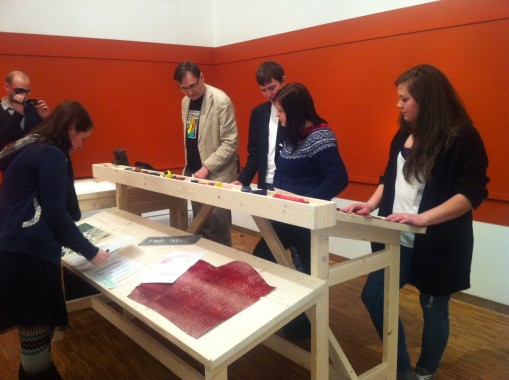
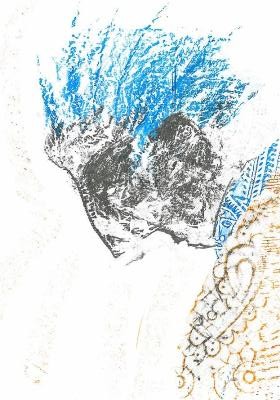 Most people are familiar with the very concept of rubbing images onto paper, for example, with tracing details of a coin by first covering it with a sheet of paper and then let the pencil run over it. In the exhibition “Neither print – nor drawing: the rubbings of Edvard Munch”, the audience is invited to experiment with the technique of frottage. On this occasion, the Munch Museum launches a competition where we will pick a weekly winner. The “Frottage of the week” will be presented on one of the walls in the last exhibition-hall and on the museum’s website. The winner may choose between a range of exciting prizes from the museum shop. The exhibition goes on until 28 May 2012, and at the end of the exhibition period, three main winners will be chosen. More about the competition here.
Most people are familiar with the very concept of rubbing images onto paper, for example, with tracing details of a coin by first covering it with a sheet of paper and then let the pencil run over it. In the exhibition “Neither print – nor drawing: the rubbings of Edvard Munch”, the audience is invited to experiment with the technique of frottage. On this occasion, the Munch Museum launches a competition where we will pick a weekly winner. The “Frottage of the week” will be presented on one of the walls in the last exhibition-hall and on the museum’s website. The winner may choose between a range of exciting prizes from the museum shop. The exhibition goes on until 28 May 2012, and at the end of the exhibition period, three main winners will be chosen. More about the competition here.
